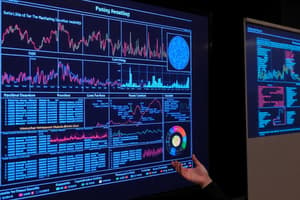Podcast
Questions and Answers
What is the primary purpose of a research poster?
What is the primary purpose of a research poster?
- To replace oral presentations completely
- To serve as a formal publication of the research
- To distribute pamphlets about the research
- To visually communicate research findings (correct)
Which part is NOT commonly included in a research poster presentation?
Which part is NOT commonly included in a research poster presentation?
- Title / Author(s) / Center(s)
- Conclusions
- Results
- Detailed literature review (correct)
Why is it important for a research poster to be visually attractive?
Why is it important for a research poster to be visually attractive?
- To serve as a standalone publication
- To impress the conference organizers
- To meet the requirements of a successful peer review
- To capture the attention of the public and encourage interaction (correct)
What aspect of a poster involves the information being conveyed?
What aspect of a poster involves the information being conveyed?
When are research posters typically exhibited?
When are research posters typically exhibited?
Which element is essential for a research poster to facilitate viewer understanding?
Which element is essential for a research poster to facilitate viewer understanding?
What format is commonly mixed into a research poster presentation aside from text?
What format is commonly mixed into a research poster presentation aside from text?
What should a research poster aim to generate among viewers?
What should a research poster aim to generate among viewers?
Flashcards are hidden until you start studying
Study Notes
Types of Contributions for Research Findings
- Abstracts summarize research succinctly, offering a brief overview of the purpose, methods, results, and conclusions.
- Oral presentations allow researchers to verbally communicate their findings, often complemented by visual aids.
Scientific Posters
- A research poster visually communicates research results and serves as a conversation starter at conferences.
- Effective posters utilize visual logic with a hierarchical structure, emphasizing key points for clarity and engagement.
- Posters are typically exhibited during special conference sessions, facilitating direct interaction between attendees and authors.
Components of a Good Poster
- Key components include:
- Title, Author(s), and Center(s)
- Introduction, Hypothesis, and Objective
- Methodology (detailed materials and methods)
- Results section showcasing findings
- Conclusions summarizing the implications and significance of the research
Focus Areas of a Poster
- Content: Clearly articulates the research objective, often encapsulating a study, experience, or specific project in a condensed format using text, tables, graphs, and images.
- Presentation: Emphasizes the delivery of the research, ensuring that the poster is visually appealing to attract viewers and encourage inquiries.
Interaction with the Audience
- Researchers are present by their posters, enabling attendees to engage directly, ask questions, and foster discussions about the research topic.
Studying That Suits You
Use AI to generate personalized quizzes and flashcards to suit your learning preferences.




